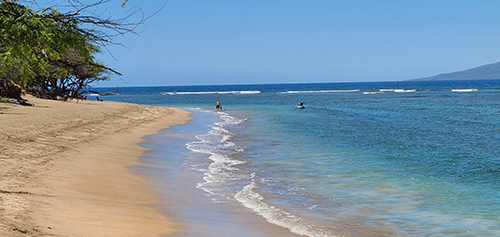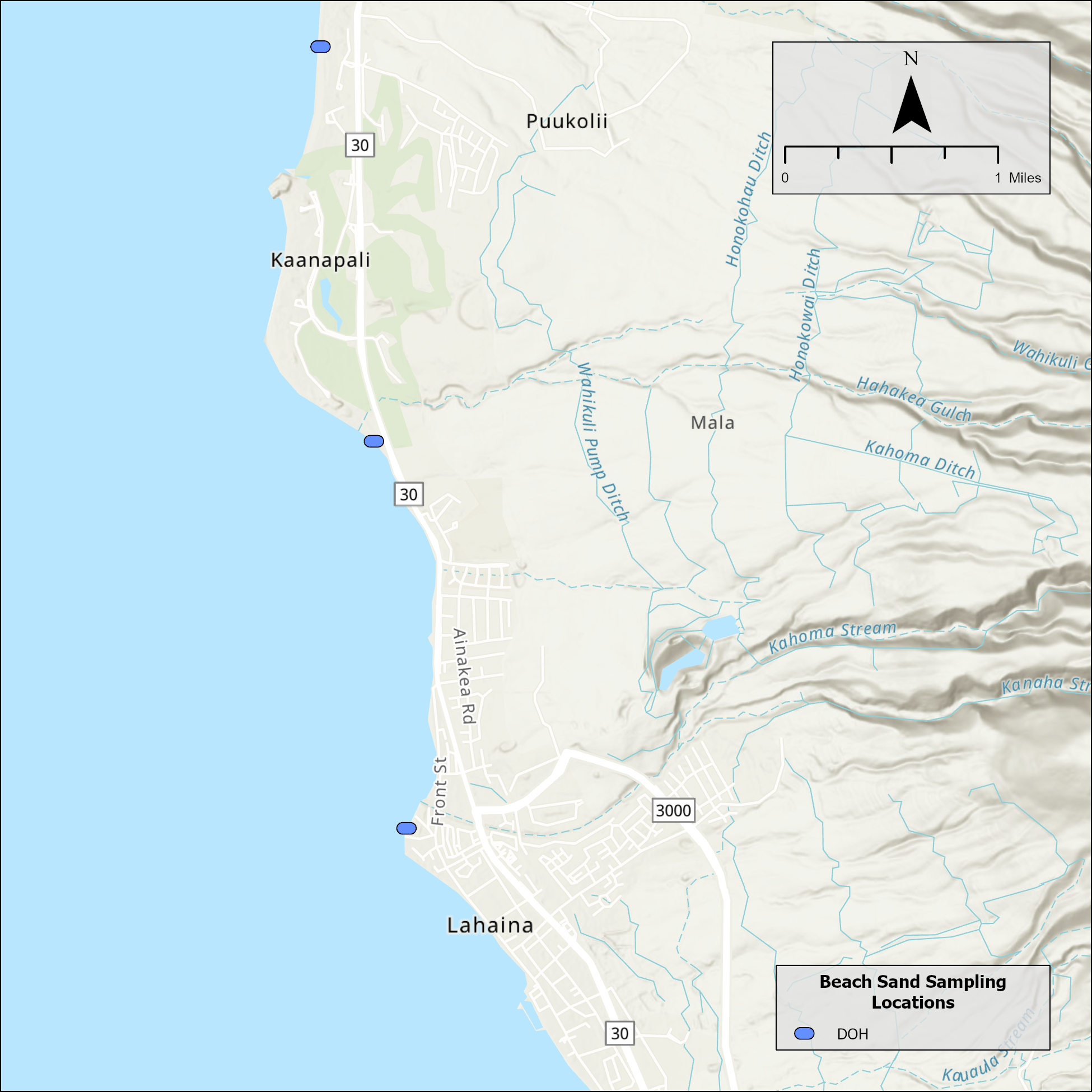Beach Sand
Air | Ash and Debris | Beach Sand | Coastal Sediment | Coastal Waters | County Parks | West Maui TDS Site | Soil
Maui Wildfire Data: Beach Sand
Beach sand sampling took place in May 2024 and is now complete. Data are available below.
Beach sand is a type of sediment composed of various materials, including decomposed rocks and organic materials. Ash from the Maui wildfires may have made its way into the sediment in ditches and streambeds and in sand along the shore. Some of the ash may have settled out of the air, though this is unlikely given the strong winds at the time of the fires. DOH and partners sampled the beach sand out of an abundance of caution and in response to public concern regarding the safety of beach recreation.
DOH and partners tested beach sand to evaluate if fire-related substances were present in the sand and to assess possible actions needed to protect public health and safety. DOH monitoring showed that fire-related substances were present at levels consistent with background levels and were not present in tested beach sand at levels that would be harmful to people.
Beach Sand Sampling
In accordance with community concerns regarding the safety of beach recreation after the wildfires, particularly for younger children, DOH selected beaches for sampling nearest the burn area. On May 15, 2024, DOH collected sand samples from three public beaches near Lahaina (Figure 1), including:
- Hanakao’o Park
- Puunoa (Baby) Beach
- Kahekili Beach
DOH selected two of the beaches, Hanakao’o Park and Puunoa (Baby) Beach, for sampling based on their heavy historic and recent recreational use. DOH chose Kahekili Beach as a reference site for data comparability. Because Kahekili Beach sand was not expected to show impacts from the wildfires, DOH compared the unaffected sand from Kahekili to sand from the other two beaches to understand fire-related effects.
DOH collected beach sand samples on May 15, 2024, in accordance with DOH’s Technical Guidance Manual (TGM), which provides in-depth guidance on collecting samples that best represent people’s possible exposure. DOH collected the beach sand samples within a 150-yard area above the high tide mark at each site. The samples were collected at depths between 0 and 3 inches. Due to the recent occurrence of the fires, fire-related ash was expected to be on the surface of the sand, within the top 3 inches of beach sand. People digging and playing in the beach sand would be highly unlikely to encounter ash at deeper depths.
Beach Sand Data and What the Data Tell Us
DOH collected the samples on May 15, 2024, in accordance with DOH protocols and procedures. These data were validated and could be used to support public health decision-making. Table 1 presents a summary of the samples, which were analyzed for various metals that could be present based on the results of ash sampling data from the Lahaina fires. The table also presents DOH’s Environmental Action Levels (EALs), which are screening values for human health. If measured levels in beach sand are below EALs for soil, then they are far below levels that would pose a risk to human health.
| Parameters | DOH EAL: Unrestricted Soil1 | Hanakao’o Park | Puunoa (Baby) Beach | Kahekili (Airport) Beach | ||||||||||||
|---|---|---|---|---|---|---|---|---|---|---|---|---|---|---|---|---|
| Aluminum | — | 3080 | 3090 | 2970 | 5620 | 5200 | 5500 | 2140 | 2480 | 2560 | ||||||
| Antimony | 6.3 | ND | ND | ND | ND | ND | ND | ND | ND | ND | ||||||
| Arsenic | 24 | 9.31 | 9.26 | 10 | 13.4 | 14.1 | 15.3 | 14.1 | 12.7 | 12.8 | ||||||
| Barium | 1000 | 4.03 | 3.88 | 4.05 | 4.19 | 4.1 | 4.5 | 5.06 | 4.69 | 5.18 | ||||||
| Beryllium | 31 | ND | ND | ND | ND | ND | ND | ND | ND | ND | ||||||
| Cadmium | 17 | ND | ND | ND | ND | ND | ND | ND | ND | ND | ||||||
| Chromium | 1100 | 51.2 | 47.8 | 50.7 | 36.7 | 41.9 | 46.9 | 25.4 | 26.8 | 25.8 | ||||||
| Cobalt | 80 | 24.9 | 24.2 | 26.0 | 19.6 | 23.0 | 23.6 | 11.5 | 13.0 | 11.5 | ||||||
| Copper | 630 | 7.52 | 7.53 | 7.62 | 10.6 | 11.6 | 12.8 | 3.01 | 2.85 | 3.16 | ||||||
| Iron | — | 26600 | 26000 | 24600 | 26700 | 25100 | 27200 | 12200 | 13900 | 14100 | ||||||
| Lead | 200 | ND* | ND* | 1.02 | 3.91 | 4.03 | 4.21 | ND* | ND* | ND* | ||||||
| Mercury | 4.7 | ND | ND | ND | ND | ND | ND | ND | ND | ND | ||||||
| Molybdenum | 78 | ND* | ND* | ND* | ND* | ND* | ND* | ND* | ND* | ND | ||||||
| Nickel | 410 | 379 | 374 | 399 | 272 | 304 | 349 | 205 | 234 | 208 | ||||||
| Silver | 78 | ND | ND | ND | ND | ND | ND | ND | ND | ND | ||||||
| Selenium | 78 | ND* | ND* | ND* | 1.05 | 1.22 | 1.13 | ND* | ND* | ND* | ||||||
| Thallium | 0.8 | ND | ND | ND | ND | ND | ND | ND | ND | ND | ||||||
| Titanium | — | 531 | 533 | 545 | 934 | 874 | 921 | 238 | 281 | 309 | ||||||
| Vanadium | 770 | 27.3 | 27.5 | 28.8 | 30.6 | 31.9 | 34.7 | ND* | ND* | ND* | ||||||
| Zinc | 1000 | 27.4 | 27.6 | 29.3 | 33.4 | 38.9 | 39.4 | 52.5 | 16.3 | 17 | ||||||
Beach sand samples were collected by DOH in accordance with DOH protocols.
DOH EAL: Hawaii DOH Environmental Action Level for screening. An entry of “—” means the analyte does not have an EAL.
The table shows valid sampling results from the sites, including duplicate and triplicate samples collected for quality assurance purposes.
ND: Non-detect
*Values were J flagged in the laboratory report, indicating that the result should be considered as an estimated rather than quantitative value.
1Screening values represent soil EALs for unrestricted land use obtained from DOH’s TGM EAL Surfer (Tier 1 EALs) search function (found here: Environmental Hazard Evaluation and Environmental Action Levels – HEER Office (hawaii.gov) (opens in a new tab)). from Spring 2024. Where applicable, the EAL Surfer reports natural background levels if higher than the toxicity-based action levels and may account for the bioavailability of the substance.
These results showed that reported levels of metals in beach sand were well below DOH health-based screening levels and reflected levels consistent with naturally occurring background levels for Hawaii. Volcanic soils on Maui have naturally high levels of metals in comparison to typical soils on the mainland United States, including aluminum, iron, manganese, and titanium. These naturally occurring metals could affect the levels of metals in beach sand but are tightly bound to minerals in the soil and do not pose a health risk to residents or aquatic habitats. The Hawaiian Islands Soil Metal Background Evaluation Report – 2012 (PDF, opens in a new tab) includes information on background concentrations of metals in Hawaii sediments.
Visit the Nearshore Coastal Water Quality and Sediment pages for more information and data.
Air | Ash and Debris | Beach Sand | Coastal Sediment | Coastal Waters | County Parks | West Maui TDS Site | Soil


